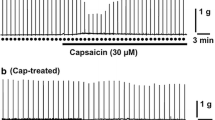Summary
-
1.
Stimulation (2–50 Hz) of the mesenteric nerves of the guinea-pig taenia caeci gave rise to contraction of the muscle obtained from animals pretreated with the adrenergic neuron-blocking agent guanethidine. Contraction was the response to stimulation at low frequencies (2–5 Hz) in about half of the untreated preparations as well.
-
2.
The response was abolished by hyoscine (4.5×10−7 M), but was unaffected by the ganglionic blocking agent mecamylamine (4.9×10−5 M). Physostigmine (2.4×10−8 M) enhanced the contractions.
-
3.
Capsaicin (9.8×10−6 M) elicited a contraction of the taenia caeci followed by a long-lasting tachyphylaxis. Contraction in response to stimulation of the mesenteric nerves was absent after this pretreatment.
-
4.
Neither the response to direct excitation of the cholinergic neural elements of the myenteric plexus, nor the relaxation caused by stimulation of adrenergic fibres were influenced by capsaicin. “Purinergic” relaxation produced by field stimulation (0.5–10 Hz) remained also unchanged.
-
5.
No functional evidence has been found for the presence of parasympathetic preganglionic fibres among the perivascular nerves supplying the taenia.
-
6.
It is concluded that capsaicin-sensitive nerves excite cholinergic neurons of the myenteric plexus.
Similar content being viewed by others
References
Akubue, P. I.: A periarterial nerve-longitudinal muscle (taenia) preparation from the guinea-pig coecum. J. Pharm. Pharmacol. 29, 122–124 (1977)
Ambache, N., Freeman, M. A.: Atropine-resistant longitudinal muscle spasm due to excitation of non-cholinergic neurones in Auerbach's plexus. J. Physiol. (Lond.) 199, 705–727 (1968)
Barthó, L., Szolcsányi, J.: The site of action of capsaicin on the guinea-pig isolated ileum. Naunyn-Schmiedeberg's Arch. Pharmacol. 305, 75–81 (1978)
Bennett, M. R.: Transmission from intramural excitatory nerves to the smooth muscle cells of the guinea-pig taenia coli. J. Physiol. (Lond.) 185, 132–147 (1966)
Bennett, M. R., Burnstock, G., Holman, M. E.: Transmission from perivascular inhibitory nerves to the smooth muscle of the guinea-pig taenia coli. J. Physiol. (Lond.) 182, 527–540 (1966)
Bianchi, C., Beani, L., Frigo, G. M., Crema, A.: Further evidence for the presence of non-adrenergic inhibitory structures in the guinea-pig colon. Eur. J. Pharmacol. 4, 51–61 (1968)
Burn, J. H., Rand, M. J.: Sympathetic post-ganglionic mechanism. Nature 184, 163–165 (1959)
Burnstock, G.: Purinergic nerves. Pharmacol. Rev. 24, 509–581 (1972)
Burnstock, G., Campbell, G., Rand, M. J.: The inhibitory innervation of the taenia of the guinea-pig caecum. J. Physiol. (Lond.) 182, 504–526 (1966)
Burnstock, G., Cocks, T., Paddle, B., Staszewska-Barczak, J.: Evidence that prostaglandin is responsible for the ‘rebound contraction’ following stimulation of non-adrenergic, noncholinergic (‘purinergic’) inhibitory nerves. Eur. J. Pharmacol. 31, 360–362 (1975)
Campbell, G.: Nerve-mediated excitation of the taenia of the guinea-pig caecum. J. Physiol. (Lond.) 185, 148–159 (1966)
Chinn, C., Hilton, J. G.: Selective activation of nicotinic and muscarinic transmission in cardiac sympathetic ganglia of the dog. Eur. J. Pharmacol. 40, 77–82 (1976)
Franco, R., Costa, M., Furness, J. B.: Evidence that axons containing Substance P in the guinea-pig ileum are of intrinsic origin. Naunyn-Schmiedeberg's Arch. Pharmacol. 307, 57–63 (1979)
Garcia Leme, J., Hamamura, L.: Formation of factor increasing vascular permeability during electrical stimulation of the saphenous nerve in rats. Br. J. Pharmacol. 51, 383–389 (1974)
Garry, R. C., Gillespie, J. S.: The response of the musculature of the colon of the rabbit to stimulation, in vitro, of the parasympathetic and of the sympathetic outflows. J. Physiol. (Lond.) 128, 557–576 (1955)
Gillespie, J. S., Maclaren, A., Pollock, D.: A method of stimulating different segments of the autonomic outflow from the spinal column to various organs in the pithed cat and rat. Br. J. Pharmacol. 40, 257–267 (1970)
Hobbiger, F., Mitchelson, F., Rand, M. J.: The action of some cholinomimetic drugs on the isolated taenia of the guinea-pig caecum. Br. J. Pharmacol. 36, 53–69 (1969)
Hultén, L.: Extrinsic nervous control of colonic motility and blood flow. Acta Physiol. Scand. Suppl. 335 (1969)
Jancsó, N., Jancsó-Gábor, A., Szolcsányi, J.: Direct evidence for neurogenic inflammation and its prevention by denervation and by pretreatment with capsaicin. Br. J. Pharmacol. 31, 138–151 (1967)
Jancsó-Gábor, A., Szolcsányi, J.: Action of rare earth metal complexes on neurogenic as well as on bradykinin-induced inflammation. J. Pharm. Pharmacol. 22, 366–371 (1970)
Jancsó-Gábor, A., Szolcsányi, J.: Neurogenic inflammatory responses. J. Dent. Res. 51, 264–269 (1972)
Ng, K. K. F.: The effect of some anticholinesterases on the response of the taenia to sympathetic nerve stimulation. J. Physiol. (Lond.) 182, 233–243 (1966)
Rand, M. J., Ridehalgh, A.: Actions of hemicholinium and triethylcholine on responses of guinea-pig colon to stimulation of autonomic nerves. J. Pharm. Pharmacol. 17, 144–156 (1965)
Szolcsányi, J.: A pharmacological approach to elucidation of the role of different nerve fibres and receptor endings in mediation of pain. J. Physiol. (Paris) 73, 251–259 (1977)
Szolcsányi, J.: Pungent agents producing pyrexia. In: Handbook of experimental pharmacology. Pyretics and anti-pyretics (A. S. Milton, ed.). Berlin, Heidelberg, New York: Springer (in press, 1979)
Szolcsányi, J., Barthó, L.: New type of nerve-mediated cholinergic contractions of the guinea-pig small intestine and its selective blockade by capsaicin. Naunyn-Schmiedeberg's Arch. Pharmacol. 305, 83–90 (1978)
Szolcsányi, J., Jancsó-Gábor, A.: Sensory effects of capsaicin congeners. Part II: Importance of chemical structure and pungency in desensitizing activity of capsaicin-type compounds. Arzneim.-Forsch. 26, 33–37 (1976)
Szolcsányi, J., Jancsó-Gábor, A., Joó, F.: Functional and fine structural characteristics of the sensory neuron blocking effect of capsaicin. Naunyn-Schmideberg's Arch. Pharmacol. 287, 157–169 (1975)
Szolcsányi, J., Jancsó-Gábor, A., Salamon, I.: Vascular permeability-increasing effect of electrical stimulation of peripheral nerves, sensory ganglia and spinal roots. Acta Physiol. Acad. Sci. Hung. 47, 255 (1976)
Author information
Authors and Affiliations
Additional information
This work was supported by the Scientific Research Council, Ministry of Public Health, Hungary, Grant No. 3-04-0101-02-2/V.
Rights and permissions
About this article
Cite this article
Szolcsányi, J., Barthó, L. Capsaicin-sensitive innervation of the guinea-pig taenia caeci. Naunyn-Schmiedeberg's Arch. Pharmacol. 309, 77–82 (1979). https://doi.org/10.1007/BF00498759
Received:
Accepted:
Issue Date:
DOI: https://doi.org/10.1007/BF00498759




